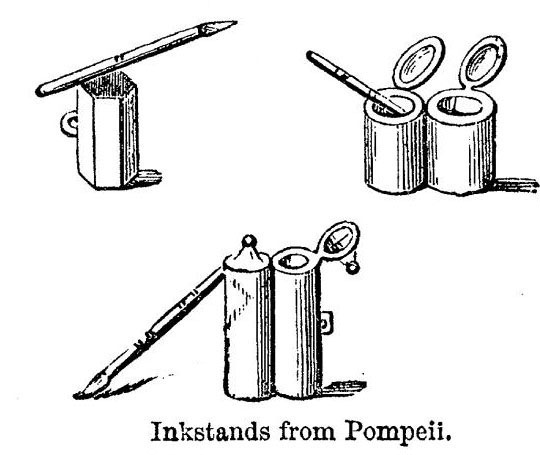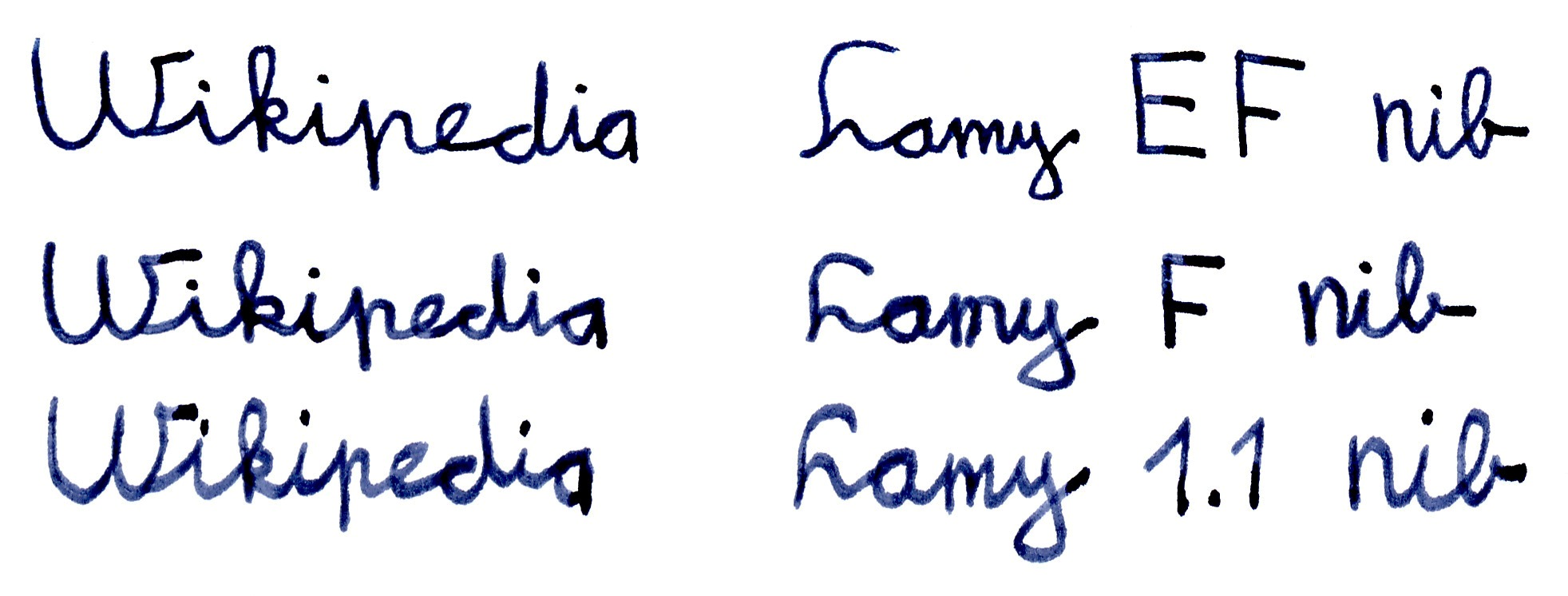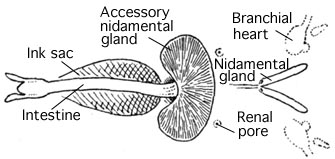|
Atramentum
Atramentum or atrament, generally means a very black, usually liquid, substance. For example, an octopus may emit a puff of atrament (see cephalopod ink). In ancient Rome, the term ''atramentum'' signified any black colouring substance used for any purpose. The Romans distinguished three principal kinds of atramentum, one called ''librarium'' (or ''scriptorium''), another called ''sutorium'', the third ''tectorium''. Atramentum librarium was the writing ink of Roman times, atramentum sutorium was used by shoemakers for dyeing leather, and atramentum tectorium (or pidorium) was used by painters for some purposes, apparently as a sort of varnish. ''Atramentous'' is a related adjective which means "black as ink". Historically, ''to atrament something'' would mean to write something down with ink. The word ''atrament'' is related to modern English ''atrocious'': both originate from Latin ''atrare'', which presumably meant to make something black. According to the ''Pigment Compendi ... [...More Info...] [...Related Items...] OR: [Wikipedia] [Google] [Baidu] |
Coprinopsis Atramentaria
''Coprinopsis atramentaria'', commonly known as the common ink cap or inky cap, is an edible (although poisonous when combined with alcohol) mushroom found in Europe and North America. Previously known as ''Coprinus atramentarius'', it is the second best known ink cap and previous member of the genus '' Coprinus'' after '' C. comatus''. It is a widespread and common fungus found throughout the northern hemisphere. Clumps of mushrooms arise after rain from spring to autumn, commonly in urban and disturbed habitats such as vacant lots and lawns, as well as grassy areas. The grey-brown cap is initially bell-shaped before opening, after which it flattens and disintegrates. The flesh is thin and the taste mild. It can be eaten, but due to the presence of coprine within the mushroom, it is poisonous when consumed with alcohol, as it heightens the body's sensitivity to ethanol in a similar manner to the anti-alcoholism drug disulfiram. For this reason, the ink cap has an additi ... [...More Info...] [...Related Items...] OR: [Wikipedia] [Google] [Baidu] |
Apelles
Apelles of Kos (; grc-gre, Ἀπελλῆς; fl. 4th century BC) was a renowned painter of ancient Greece. Pliny the Elder, to whom much of modern scholars' knowledge of this artist is owed ('' Naturalis Historia'' 35.36.79–97 and ''passim''), rated him superior to preceding and subsequent artists. He dated Apelles to the 112th Olympiad (332–329 BC), possibly because he had produced a portrait of Alexander the Great. Biography Probably born at Colophon in Ionia, he first studied under Ephorus of Ephesus, but after he had attained some celebrity he became a student to Pamphilus at Sicyon He thus combined the Dorian thoroughness with the Ionic grace. Attracted to the court of Philip II, he painted him and the young Alexander with such success that he became the recognized court painter of Macedon, and his picture of Alexander holding a thunderbolt ranked in the minds of many with the Alexander with the spear of the sculptor Lysippus. Hundreds of years later, Pl ... [...More Info...] [...Related Items...] OR: [Wikipedia] [Google] [Baidu] |
Iron Oxide
Iron oxides are chemical compounds composed of iron and oxygen. Several iron oxides are recognized. All are black magnetic solids. Often they are non-stoichiometric. Oxyhydroxides are a related class of compounds, perhaps the best known of which is rust. Iron oxides and oxyhydroxides are widespread in nature and play an important role in many geological and biological processes. They are used as iron ores, pigments, catalysts, and in thermite, and occur in hemoglobin. Iron oxides are inexpensive and durable pigments in paints, coatings and colored concretes. Colors commonly available are in the "earthy" end of the yellow/orange/red/brown/black range. When used as a food coloring, it has E number E172. Stoichiometries Iron oxides feature as ferrous ( Fe(II)) or ferric (Fe(III)) or both. They adopt octahedral or tetrahedral coordination geometry. Only a few oxides are significant at the earth's surface, particularly wüstite, magnetite, and hematite. * Oxides of ... [...More Info...] [...Related Items...] OR: [Wikipedia] [Google] [Baidu] |
Shulhan Arukh
The ''Shulchan Aruch'' ( he, שֻׁלְחָן עָרוּך , literally: "Set Table"), sometimes dubbed in English as the Code of Jewish Law, is the most widely consulted of the various legal codes in Judaism. It was authored in Safed (today in Israel) by Joseph Karo in 1563 and published in Venice two years later. Together with its commentaries, it is the most widely accepted compilation of Jewish law ever written. The '' halachic'' rulings in the ''Shulchan Aruch'' generally follow Sephardic law and customs, whereas Ashkenazi Jews generally follow the halachic rulings of Moses Isserles, whose glosses to the ''Shulchan Aruch'' note where the Sephardic and Ashkenazi customs differ. These glosses are widely referred to as the ''mappah'' (literally: the "tablecloth") to the ''Shulchan Aruch's'' "Set Table". Almost all published editions of the ''Shulchan Aruch'' include this gloss, and the term "Shulchan Aruch" has come to denote ''both'' Karo's work as well as Isserles', with Karo ... [...More Info...] [...Related Items...] OR: [Wikipedia] [Google] [Baidu] |
Copper(II) Sulfate
Copper(II) sulfate, also known as copper sulphate, is an inorganic compound with the chemical formula . It forms hydrates , where ''n'' can range from 1 to 7. The pentahydrate (''n'' = 5), a bright blue crystal, is the most commonly encountered hydrate of copper(II) sulfate. Older names for the pentahydrate include blue vitriol, bluestone, vitriol of copper,Antoine-François de Fourcroy, tr. by Robert Heron (1796) "Elements of Chemistry, and Natural History: To which is Prefixed the Philosophy of Chemistry". J. Murray and others, Edinburgh. Page 348. and Roman vitriol.Oxford University Press,Roman vitriol, Oxford Living Dictionaries. Accessed on 2016-11-13 It exothermically dissolves in water to give the aquo complex , which has octahedral molecular geometry. The structure of the solid pentahydrate reveals a polymeric structure wherein copper is again octahedral but bound to four water ligands. The centers are interconnected by sulfate anions to form chains. Anhydrous copper su ... [...More Info...] [...Related Items...] OR: [Wikipedia] [Google] [Baidu] |
Sofer (scribe)
A sofer, sopher, sofer SeTaM, or sofer ST"M ( he, סופר סת״ם, "scribe"; plural of is , ; female: ) is a Jewish scribe who can transcribe Sifrei Kodesh (holy scrolls), tefillin (phylacteries), mezuzot (ST"M, , is an abbreviation of these three terms) and other religious writings. By simple definition, soferim are copyists, but their religious role in Judaism is much more. Besides sifrei Torah, tefillin, and mezuzot, scribes are necessary to write the Five Megillot (scrolls of the Song of Songs, Book of Ruth, Book of Esther, Ecclesiastes, and Book of Lamentations), Nevi'im (the books of the prophets, used for reading the haftarah), and for , divorce documents. Many scribes also function as calligraphers—writing functional documents such as (marriage contracts), or ornamental and artistic renditions of religious texts, which do not require any scribal qualifications, and to which the rules on lettering and parchment specifications do not apply. The major halakha pe ... [...More Info...] [...Related Items...] OR: [Wikipedia] [Google] [Baidu] |
Iron Gall Ink
Iron gall ink (also known as common ink, standard ink, oak gall ink or iron gall nut ink) is a purple-black or brown-black ink made from iron salts and tannic acids from vegetable sources. It was the standard ink formulation used in Europe for the 1400-year period between the 5th and 19th centuries, remained in widespread use well into the 20th century, and is still sold today. Preparation and use The ink was traditionally prepared by adding some iron(II) sulfate ( Fe S O4) to a solution of tannic acid, but any iron ion donor can be used. The gallotannic acid was usually extracted from oak galls or galls of other trees, hence the name. Fermentation or hydrolysis of the extract releases glucose and gallic acid, which yields a darker purple-black ink, due to the formation of iron gallate. The fermented extract was combined with the iron(II) sulfate. After filtering, the resulting pale-grey solution had a binder added to it (most commonly gum arabic) and was used to write ... [...More Info...] [...Related Items...] OR: [Wikipedia] [Google] [Baidu] |
Linseed Oil
Linseed oil, also known as flaxseed oil or flax oil (in its edible form), is a colourless to yellowish oil obtained from the dried, ripened seeds of the flax plant (''Linum usitatissimum''). The oil is obtained by pressing, sometimes followed by solvent extraction. Owing to its polymer-forming properties, linseed oil is often blended with combinations of other oils, resins or solvents as an impregnator, drying oil finish or varnish in wood finishing, as a pigment binder in oil paints, as a plasticizer and hardener in putty, and in the manufacture of linoleum. Linseed oil use has declined over the past several decades with increased availability of synthetic alkyd resins—which function similarly but resist yellowing. Linseed oil is an edible oil in demand as a dietary supplement, as a source of α-Linolenic acid, an omega-3 fatty acid. In parts of Europe, it is traditionally eaten with potatoes and quark. Structure and composition : 450px, Representative triglyceride f ... [...More Info...] [...Related Items...] OR: [Wikipedia] [Google] [Baidu] |
Tannic Acid
Tannic acid is a specific form of tannin, a type of polyphenol. Its weak acidity ( pKa around 6) is due to the numerous phenol groups in the structure. The chemical formula for commercial tannic acid is often given as C76H52O46, which corresponds with decagalloyl glucose, but in fact it is a mixture of polygalloyl glucoses or polygalloyl quinic acid esters with the number of galloyl moieties per molecule ranging from 2 up to 12 depending on the plant source used to extract the tannic acid. Commercial tannic acid is usually extracted from any of the following plant parts: Tara pods (''Caesalpinia spinosa''), gallnuts from '' Rhus semialata'' or ''Quercus infectoria'' or Sicilian sumac leaves ('' Rhus coriaria''). According to the definitions provided in external references such as international pharmacopoeia, Food Chemicals Codex and FAO-WHO tannic acid monograph only tannins obtained from the above-mentioned plants can be considered as tannic acid. Sometimes extracts from che ... [...More Info...] [...Related Items...] OR: [Wikipedia] [Google] [Baidu] |
Pigment
A pigment is a colored material that is completely or nearly insoluble in water. In contrast, dyes are typically soluble, at least at some stage in their use. Generally dyes are often organic compounds whereas pigments are often inorganic compounds. Pigments of prehistoric and historic value include ochre, charcoal, and lapis lazuli. Economic impact In 2006, around 7.4 million tons of inorganic, organic, and special pigments were marketed worldwide. Estimated at around US$14.86 billion in 2018 and will rise at over 4.9% CAGR from 2019 to 2026. The global demand for pigments was roughly US$20.5 billion in 2009. According to an April 2018 report by ''Bloomberg Businessweek'', the estimated value of the pigment industry globally is $30 billion. The value of titanium dioxide – used to enhance the white brightness of many products – was placed at $13.2 billion per year, while the color Ferrari red is valued at $300 million each year. Physical principles ... [...More Info...] [...Related Items...] OR: [Wikipedia] [Google] [Baidu] |
Cephalopod Ink
Cephalopod ink is a dark-coloured or luminous ink released into water by most species of cephalopod, usually as an escape mechanism. All cephalopods, with the exception of the Nautilidae and the Cirrina (deep-sea octopuses), are able to release ink to confuse predators. The ink is released from the ink sacs (located between the gills) and is dispersed more widely when its release is accompanied by a jet of water from the siphon. Its dark color is caused by its main constituent, melanin. Each species of cephalopod produces slightly differently coloured inks; generally, octopuses produce black ink, squid ink is blue-black, and cuttlefish ink is a shade of brown. A number of other aquatic molluscs have similar responses to attack, including the gastropod clade known as sea hares. Types of ink shapes The shapes taken by ink releases are classified as six types: * pseudomorphs; * pseudomorph series; * ink ropes; * clouds/smokescreens; * diffuse puffs; * mantle fills. Inking b ... [...More Info...] [...Related Items...] OR: [Wikipedia] [Google] [Baidu] |








